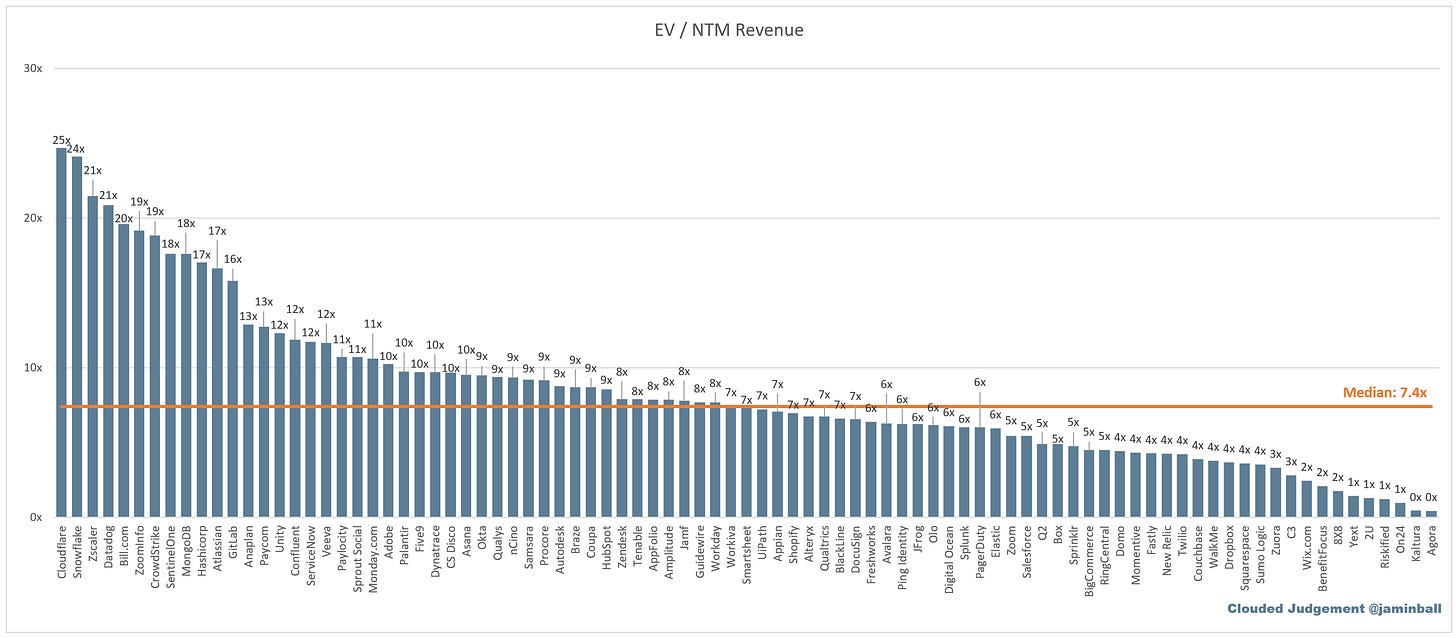Clouded Judgement 5.6.22
Every week I’ll provide updates on the latest trends in cloud software companies. Follow along to stay up to date!
How Far Have We Fallen??
What a few weeks / months for cloud software. While it’s felt like the world has fallen off a cliff (and we have), where we stand today really isn’t that crazy. The 5 year average cloud software multiple (pre covid, so 2015-2020) was 7.8x NTM revenue. The current median is 7.4x. So despite the MASSIVE correction (many companies down 50-80%), we’re only 5% below what I would consider a “normal” multiple. I think everyone would agree it’s hard to feel “normal” right now. Now, I’d argue that the quality of the cloud software basket today is higher than what it was from 2015-2020. So comparing the LT average to current median isn’t totally apples to apples. I took a swag at what the LT average would be if it included companies that are public today but not back then (the list is long), but we’d still only be ~10-15% below the long term average. It can be a bit jarring thinking about this given it sure feels like we should be well below the long term average.
Quarterly Reports Summary
Top 10 EV / NTM Revenue Multiples
Top 10 Weekly Share Price Movement
Update on Multiples
SaaS businesses are valued on a multiple of their revenue - in most cases the projected revenue for the next 12 months. Multiples shown below are calculated by taking the Enterprise Value (market cap + debt - cash) / NTM revenue.
Overall Stats:
Overall Median: 7.4x
Top 5 Median: 21.5x
3 Month Trailing Average: 9.0x
1 Year Trailing Average: 13.2x
Bucketed by Growth. In the buckets below I consider high growth >30% projected NTM growth, mid growth 15%-30% and low growth <15%
High Growth Median: 9.7x
Mid Growth Median: 7.2x
Low Growth Median: 3.6x
Scatter Plot of EV / NTM Rev Multiple vs NTM Rev Growth
How correlated is growth to valuation multiple?
Growth Adjusted EV / NTM Rev
The below chart shows the EV / NTM revenue multiple divided by NTM consensus growth expectations. The goal of this graph is to show how relatively cheap / expensive each stock is relative to their growth expectations
Operating Metrics
Median NTM growth rate: 25%
Median LTM growth rate: 34%
Median Gross Margin: 74%
Median Operating Margin (23%)
Median FCF Margin: 3%
Median Net Retention: 120%
Median CAC Payback: 27 months
Median S&M % Revenue: 45%
Median R&D % Revenue: 26%
Median G&A % Revenue: 20%
Comps Output
Rule of 40 shows LTM growth rate + LTM FCF Margin. FCF calculated as Cash Flow from Operations - Capital Expenditures
GM Adjusted Payback is calculated as: (Previous Q S&M) / (Net New ARR in Q x Gross Margin) x 12 . It shows the number of months it takes for a SaaS business to payback their fully burdened CAC on a gross profit basis. Most public companies don’t report net new ARR, so I’m taking an implied ARR metric (quarterly subscription revenue x 4). Net new ARR is simply the ARR of the current quarter, minus the ARR of the previous quarter. Companies that do not disclose subscription rev have been left out of the analysis and are listed as NA.
This post and the information presented are intended for informational purposes only. The views expressed herein are the author’s alone and do not constitute an offer to sell, or a recommendation to purchase, or a solicitation of an offer to buy, any security, nor a recommendation for any investment product or service. While certain information contained herein has been obtained from sources believed to be reliable, neither the author nor any of his employers or their affiliates have independently verified this information, and its accuracy and completeness cannot be guaranteed. Accordingly, no representation or warranty, express or implied, is made as to, and no reliance should be placed on, the fairness, accuracy, timeliness or completeness of this information. The author and all employers and their affiliated persons assume no liability for this information and no obligation to update the information or analysis contained herein in the future.













Thank you Jamin for your weekly analysis. Do you have the ability to show how many companies that have reported 1Q earnings have lowered their expectations? Started to see some anecdotal earnings comments around this while Microsoft made the case for continuing as expected or better.
I find these summaries very helpful to gaining/keeping perspective. Thank you so much for your work.
Your tables do have so many columns that I'd find it most helpful if alternating rows were shaded to aid in keeping data visually aligned with the stock name.